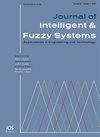Multi-view weighted feature fusion with wavelet transform and CNN for enhanced CT image recognition
IF 1
4区 计算机科学
Q3 COMPUTER SCIENCE, ARTIFICIAL INTELLIGENCE
引用次数: 0
Abstract
Reducing noise in CT images and extracting key features are crucial for improving the accuracy of medical diagnoses, but it remains a challenging problem due to the complex characteristics of CT images and the limitations of existing methods. It is worth noting that multiple views can provide a richer representation of information compared to a single view, and the unique advantages of the wavelet transform in feature analysis. In this study, a novel Multi-View Weighted Feature Fusion algorithm called MVWF is proposed to address the challenge of enhancing CT image recognition utilizing wavelet transform and convolutional neural networks. In the proposed approach, the wavelet transform is employed to extract both detailed and primary features of CT images from two views, including high frequency and low frequency. To mitigate information loss, the source domain is also considered as a view within the multi-view structure. Furthermore, AlexNet is deployed to extract deeper features from the multi-view structure. Additionally, the MVWF algorithm introduces a balance factor to account for both specific information and global information in CT images. To accentuate significant multi-view features and reduce feature dimensionality, random forest is used to assess feature importance followed by weighted fusion. Finally, CT image recognition is accomplished using the SVM classifier. The performance of the MVWF algorithm has been compared with classical multi-view algorithms and common single-view methods on COVID-CT and SARS-COV-2 datasets. The experimental results indicate that an average improvement of 6.8% in CT image recognition accuracy can be achieved by utilizing the proposed algorithm. Particularly, the MVF algorithm and MVWF algorithm have attained AUC values of 0.9972 and 0.9982, respectively, under the SARS-COV-2 dataset, demonstrating outstanding recognition performance. The proposed algorithms can capture more robust and comprehensive high-quality feature representation by considering feature correlations across views and feature importance based on Multi-view.基于小波变换和CNN的多视图加权特征融合增强CT图像识别
降低CT图像中的噪声和提取关键特征对于提高医学诊断的准确性至关重要,但由于CT图像的复杂特性和现有方法的局限性,这仍然是一个具有挑战性的问题。值得注意的是,与单一视图相比,多视图可以提供更丰富的信息表示,以及小波变换在特征分析中的独特优势。在本研究中,提出了一种新的多视图加权特征融合算法MVWF来解决利用小波变换和卷积神经网络增强CT图像识别的挑战。该方法利用小波变换从高频和低频两个角度提取CT图像的细节特征和主要特征。为了减少信息丢失,源域也被视为多视图结构中的一个视图。此外,部署AlexNet从多视图结构中提取更深层次的特征。此外,MVWF算法引入了一个平衡因子来考虑CT图像中的特定信息和全局信息。为了突出重要的多视图特征,降低特征维数,采用随机森林对特征重要性进行评估,然后进行加权融合。最后,利用支持向量机分类器完成CT图像识别。在COVID-CT和SARS-COV-2数据集上,将MVWF算法与经典多视图算法和常用单视图算法的性能进行了比较。实验结果表明,该算法可使CT图像识别准确率平均提高6.8%。其中,MVF算法和MVWF算法在SARS-COV-2数据集下的AUC值分别达到0.9972和0.9982,表现出优异的识别性能。该算法通过考虑视图间的特征相关性和基于多视图的特征重要性,可以获得更鲁棒和全面的高质量特征表示。
本文章由计算机程序翻译,如有差异,请以英文原文为准。
求助全文
约1分钟内获得全文
求助全文
来源期刊

Journal of Intelligent & Fuzzy Systems
工程技术-计算机:人工智能
CiteScore
3.40
自引率
10.00%
发文量
965
审稿时长
5.1 months
期刊介绍:
The purpose of the Journal of Intelligent & Fuzzy Systems: Applications in Engineering and Technology is to foster advancements of knowledge and help disseminate results concerning recent applications and case studies in the areas of fuzzy logic, intelligent systems, and web-based applications among working professionals and professionals in education and research, covering a broad cross-section of technical disciplines.
 求助内容:
求助内容: 应助结果提醒方式:
应助结果提醒方式:


